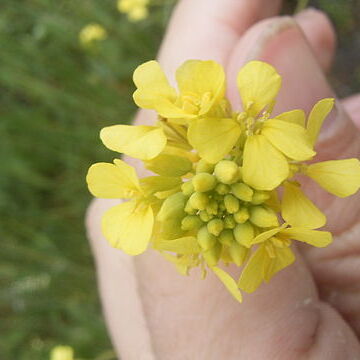Annual, biennial or perennial taprooted herbs. Hairs simple. Stems erect, leafy. Lower lvs pinnatifid or pinnate, rarely not lobed; upper lvs usually simple. Racemes ebracteate. Sepals erecto-patent, the inner saccate. Petals yellow, veined. Stamens 6, without appendages. Lateral nectaries 2, united, inside bases of lateral stamens; median nectaries 2, ligulate, outside bases of median stamens. Stigma sessile, capitate or weakly 2-lobed. Silicle indehiscent, composed of 2 segments, woody within and corky without; lower segment cylindric or barrel-shaped, 0-2-seeded; upper segment larger, ovoid to turbinate, usually 1-seeded, falling when ripe. Seeds brown, ovoid, not winged.
Sep ascending, cucullate at the tip; pet yellow, narrowly obovate, gradually narrowed to the claw; short stamens subtended by a flat gland, long stamens by a short-conic gland; anthers oblong; ovary cylindric, the style about as thick, the stigma truncate; fr short, terete, coriaceous, tipped by the elongate, persistent style, transversely divided into 2 members, the lower cylindric to obovoid, dehiscent by 2 valves, bearing 1–3 suspended seeds, the upper larger, subglobose, indehiscent, obtusely 5-ribbed and usually verrucose, containing one erect seed; hairs simple. 2, w. Eurasia, Mediterranean.
Annual or biennial herbs. Sepals half-spreading, the inner pair slightly saccate. Petals shortly clawed. Stamens 6. Nectariferous glands 4, a variously shaped glands inside base of short stamens, short ligulate glands outside base of long stamens. Silicula indehiscent, differentiated into two segments; lower segment cylindrical, with 0–2 pendulous seeds, upper segment globular, ribbed, l-seeded, beaked. Cotyledons conduplicate; radicle incumbent.

